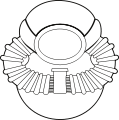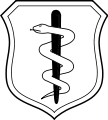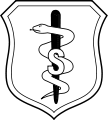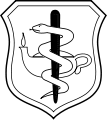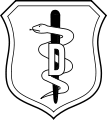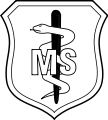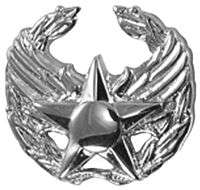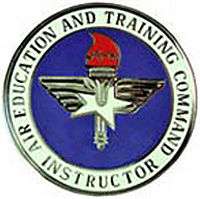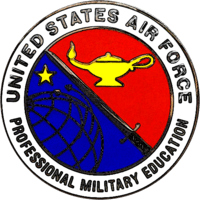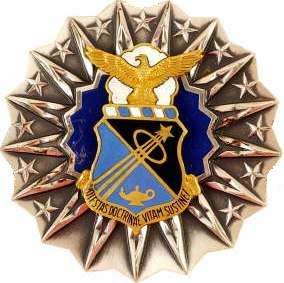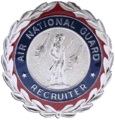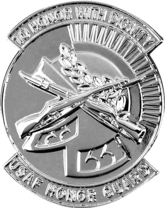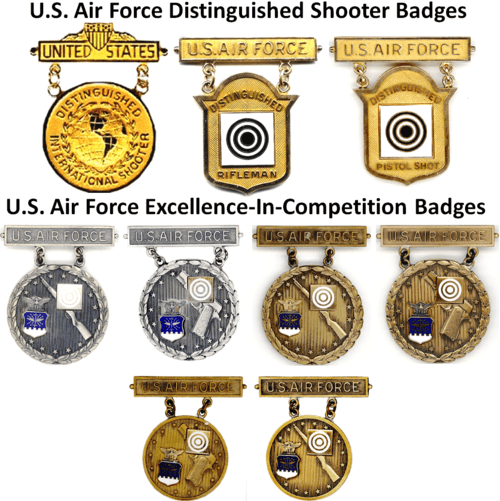Badges of the United States Air Force


Badges of the United States Air Force are military awards authorized by the United States Air Force that signify aeronautical ratings, special skills, career field qualifications, and serve as identification devices for personnel occupying certain assignments. The newest badge to be authorized for wear is the Cyberspace Operator Badge, first awarded to qualified officers on April 30, 2010 at Bolling Air Force Base, Washington, DC.[1][2]
Most Air Force badges are awarded in three degrees or skill levels. Aeronautical rating badges for Pilots (including operators of remotely piloted aircraft), Navigators/Combat Systems Officers/Observers, and Air Battle Managers are awarded at Basic, Senior, and Command levels; while flight nurses and flight surgeons are awarded ratings at the Basic, Senior, and Chief levels. All other aviation badges are awarded at the Basic, Senior, and Master levels. Occupational badges are normally issued in Basic, Senior, and Master level for officers. Enlisted wear the basic badge after completing technical school, the senior badge after award of the 7-skill level, and the master badge as a master sergeant or above with 5 years in the specialty from award of the 7-skill level. A star and wreath system, worn above the Air Force badge, denotes which degree or skill level a service member currently holds.[1]
Chaplain, aeronautical, space, cyberspace, and missile operations badges, along with the Air Force Commander's Insignia are mandatory for wear on Air Force uniforms. With the most recent changes to Air Force uniform regulations, restrictions have been lifted on the wear of other service's skill badges that Airman have earned. Unless otherwise stated, the badges listed below are presented in order of precedence. Precedence of badges within the same category depends on the airman's current assignment.[1][3]
The Air Force is the most restrictive service with regards to which Air Force badges may be worn on the uniforms by other branches of the US Armed Forces. Most badges issued exclusively by the Air Force may only be displayed on Air Force uniforms. The exception to this rule is the Space Operations Badge.[1][4]
The Air Force previously authorized continued use of a number of aviation badges originally issued by the U.S. Army during World War II. Such badges are no longer authorized and are now categorized as obsolete badges.
Aviation Badges
Aeronautical Rating Badges
-

Astronaut Badge (Any Pilot, Navigator, Combat Systems Officer, Observer, Air Battle Manager, or Flight Surgeon Badge with Astronaut Device)
Aircrew Badges
Joint Service Qualification Badges
As of 17 January 2014, Airmen are authorized to wear any qualification/skill badge they have earned on Air Force uniforms. The qualification badges listed below are joint badges that are specifically awarded by the Air Force as well as other services.[1][5]
-

Explosive Ordnance Disposal Badges (Basic, Senior, and Master)
-

Parachutist Badges (Basic, Senior, and Master)
-

Freefall Parachutist Badges (Basic and Master)
- ^ First Air Force Dive Course Graduates 17 Airmen, U.S. Air Force Official Website, posted 16 March 2006, last accessed 13 April 2013
Occupational Badges
An Air Force Occupational Badge is a military badge of the United States Air Force which is awarded to those members of the Air Force community who are engaged in duties “other than flying”. The purpose of the Air Force Occupational Badge is to denote and recognize training, education and qualifications received in a particular career field and to provide recognition in an outwardly displayed badge.[1][6]
The first Air Force Occupational Badges began appearing on Air Force uniforms in the late 1950s. Prior to this time, the only Air Force badges authorized were the Pilot’s Badge and other aeronautical rating badges such as the Navigator Badge and Flight Surgeon Badge.
Operations Career Group
-

Space Operations Badge (This badge is equal in precedence to aviation badges.)
-

Cyberspace Operator Badge (This badge is equal in precedence to aviation badges.)
-

Operations Support Badge
-

Command and Control Badge
-

Air Traffic Control Badge
-

Airfield Systems and Radar Maintenance Badge
-

Intelligence Badge
-

Meteorologist Badge
The following operations insignia are worn as flashes or crests on unique Air Force berets instead of the left breast of Air Force uniforms. Both the breast insignia and the following flashes/crests signify the same thing, an Air Force specialty.[7]
-

Special Tactics Officer (STO) Flash
-

Combat Controller (CCT) Flash
-
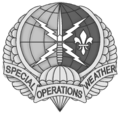
Special Operations Weather Team (SOWT) Flash
-

Tactical Air Control Party (TACP) Crest
-

Air Liaison Officer (ALO) Flash[1] (also worn behind TACP Crest)
-

Combat Rescue Officer (CRO) Flash
-

Pararescueman (PJ) Flash
-

Survival, Evasion, Resistance and Escape (SERE) Flash
- ^ AFSC 13LXX AIR LIAISON OFFICER, CAREER FIELD EDUCATION AND TRAINING PLAN, DEPARTMENT OF THE AIR FORCE, dated 21 May 2013, last accessed 27 November 2016
Logistics Career Group
-

Maintenance & Munitions Badge
-

Logistics Readiness Badge
-

Supply and Fuels Badge
-

Transportation Badge
-

Logistics Plans Badge
Support Career Group
-

Administration Badge
-

Cyberspace Support Badge (Enlisted)
-

Band Badge
-

Public Affairs Badge
-

Historian Badge
-

Manpower and Personnel Badge (Enlisted)
-
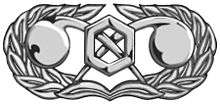
Emergency Management Badge
-

Civil Engineer Badge
-

Services Badge (Enlisted)
-

Force Support Badge (Officer)
Special Investigations Career Group
-

Force Protection Badge
Professional Career Group
-

Judge Advocate Badge
-

Chaplain Badges (These badges have precedence over other badges.)
-

Paralegal Badge (Enlisted)
-

Chaplain Service Support Badge (Enlisted)
Acquisition Career Group
-

Acquisition and Financial Management Badge
Medical Career Group
Duty Badges
Sources:[1]
Award Badges
- ^ a b Cite error: The named reference
AFI36-2903was invoked but never defined (see the help page). - ^ AFI34-143: Excellence-In-Competition (EIC), dated 21 Feb 12, last accessed 11 January 2014
See also
- U.S. Air Force Aeronautical Ratings
- Air Force Specialty Code
- Military badges of the United States
- Obsolete badges of the United States military
References
- 1 2 3 4 5 6 7 8 AFI36-2903: Dress and Personal Appearance of Air Force Personnel; dated 18 July 2011; last accessed 11 January 2014
- ↑ New Air Force cyberspace badge guidelines released, posted 27 Apr 10, accessed 16 Jan 12
- ↑ AF uniform policy update: welcome back morale t-shirts, badges and limitless athletic shoes, U.S. Air Force News, by Staff Sgt. David Salanitri, dated 20 January 2014, last accessed 15 March 2014
- ↑ SMDC-OPZ-FB, ASPDO Procedural Guide #1 - Procedures for Awarding the Space Badge to Army Space Cadre Personnel, dated 15 Feb 11, accessed 16 Jan 12
- 1 2 AFI11-402: Aviation and Parachutist Service, Aeronautical Ratings and Badges; dated 13 December 2010, updated 5 February 2013, last accessed 11 January 2014
- ↑ AFI36-2101: Classifying Military Personnel (Officer and Enlisted); dated 25 June 2013, updated 18 November 2013; last accessed 11 January 2014
- ↑ Air Force Special Operations Command, Special Tactics Units; accessed August 21, 2011
